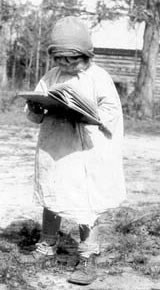This History of Public Library Service in Durham, 1897-1997 by Jessica Harland-Jacobs

Child at bookmobile stop. 1930s
Introduction
The history of Durham's public libraries, and ultimately the Durham County Library, is a story of pioneering, accomplishments and frustrating neglect, of individual effort and community enterprise, of institutional segregation and eventual integration.
Durham recorded many significant firsts in respect to library movements in other North Carolina cities: the first tax-supported public library, the first professional librarian, and the first bookmobile. Durham also boasted the second library founded for African Americans in the state. Having set these precedents, the county permitted decades to pass without significant improvement to its library facilities. Successive city and county governments approached the library with indifference and grudgingly enacted stopgap measures when appalling conditions demanded drastic improvements. Rejecting bond issues twice during the late sixties and early seventies, the majority of Durham's voting citizens shared the responsibility for Durham's ignominious library.
Despite these conditions, Durham offered continuous library service to whites from 1897 and to African Americans from 1913. This would not have been possible without the contributions of motivated, committed, and community-minded individuals like Julian Shakespeare Carr, Lillian Griggs, Aaron McDuffie Moore, Clara Crawford, Stanford Warren, Selena and John Wheeler, Ray Moore, Benjamin Powell, George Linder, and Dale Gaddis. But these individuals succeeded only because they could rely on the critical support of community organizations--the Canterbury Club, the Durham Colored Library Association, the Friends of the Durham Library, the Kiwanis, and the Junior League, to name a few. Time and again throughout the history of both libraries, individuals combined with civic groups to overcome the obstacles of insufficient funding and official neglect.
Finally, the history of Durham’s public libraries is a story of two separate library movements, both successful, but far from equal in terms of challenges and resources. When Durham established the first free, tax-supported public library in the state and proclaimed it was open to all,
it was assumed that all
did not include African Americans. But Durham's unusually prosperous and politically active African American population would not allow themselves to be denied the benefits of a public library and, less than two decades after the founding of the white library, established their own institution offering access to books. Though Durham's libraries had separate facilities, librarians, and boards of directors, their histories, parallel and intertwined, cannot be told separately. The libraries adopted the same strategies for extending their services. They developed concurrently in a shared wider context of the national library movement, the Depression, two world wars, the extension of adult education, and nation-wide debates over censorship, race relations, and the role of libraries in democracies. And eventually, after six decades of institutional segregation and several years of potentially explosive racial tension, the black and white libraries merged. When Durham finally built a new main library in 1980, it was truly free and open to all.

